Table of Contents
- Peloton Exercise Bike
- Key Features of the Peloton Exercise Bike
- Fitness and Weight Loss Benefits
- Peloton Bike vs. Competitors
- Pros and Cons of the Peloton Bike
- Pros
- Cons
- Performance and User Experience
- Cost and Value Analysis
- FAQ
- Is the Peloton Bike good for weight loss?
- Can beginners use the Peloton Bike?
- Does the Peloton Bike require a subscription?
- How durable is the Peloton Bike?
- Is the Bike+ worth the extra cost?
- Final Thoughts
- About Author
- Mariar Fernandez
As an Amazon Associate, I earn from qualifying purchases.
Peloton Exercise Bike
Peloton exercise bike delivers immersive, instructor-led workouts with a 21.5-inch HD touchscreen, burning 300-600 calories per 30-minute ride, boasting a 92% retention rate, and supporting weight loss of up to 100+ pounds when paired with diet.
Key Features of the Peloton Exercise Bike
The Peloton Bike, starting at $1,445, integrates a magnetic resistance system with 100 levels for precise intensity control, mimicking outdoor cycling. Its 21.5-inch HD touchscreen streams live and on-demand classes, while the belt-driven flywheel ensures a quiet, smooth ride. The Bike+ ($2,495) adds auto-resistance and a rotating screen for floor workouts. Both models support users up to 297 pounds, with adjustable seats and handlebars.
A 2025 Garage Gym Reviews test praised the bike’s stability during sprints, noting no wobble at high resistance. Bluetooth connectivity syncs heart rate monitors and Apple Watch, tracking cadence, output, and calories. Over 3 million monthly active users engage with 10,000+ classes, per Peloton’s Q2 2025 data.
Learn more about setup at Peloton’s official guide.
Fitness and Weight Loss Benefits
Peloton’s immersive classes drive results. Users burn 400-500 calories per 30-minute session, supporting 1-2 pounds weekly weight loss with a 500-calorie daily deficit. A 2025 BarBend study reported a tester’s VO2 max increase of 10% after eight weeks. Real-world success includes a user losing 70 pounds in 12 months through daily rides and meal planning, stating, “Peloton’s leaderboard kept me hooked.”
Low-impact cycling reduces joint stress, ideal for beginners or those with injuries. 92% of users report improved mental health, citing community features like high-fives. Peloton’s 75-day programs have led to 100-pound losses for disciplined users, per Reddit threads.
Peloton Bike vs. Competitors
The Peloton Bike excels in engagement but faces competition. Here’s a 2025 comparison:
| Feature/Bike | Peloton Bike | BowFlex C6 | NordicTrack S22i | Echelon EX-5s |
|---|---|---|---|---|
| Price | $1,445 | $600 | $1,500 | $1,200 |
| Screen Size | 21.5″ HD | None (tablet) | 22″ HD | 21.5″ HD |
| Resistance Levels | 100 | 100 | 24 digital | 32 |
| Subscription | $44/mo | $20/mo (JRNY) | $39/mo (iFit) | $35/mo |
| Unique Feature | Live classes | Budget-friendly | Auto-incline | App versatility |
| User Rating | 4.8/5 (CNET) | 4.6/5 | 4.5/5 | 4.4/5 |
Peloton leads in community; BowFlex offers value. NordicTrack’s incline mimics hills but lacks Peloton’s class variety. Explore alternatives at CNET’s bike reviews.
Pros and Cons of the Peloton Bike
Pros
- Immersive Classes: 10+ disciplines (cycling, yoga, strength); 96% retention rate.
- Build Quality: 135-pound frame; silent operation suits apartments.
- Metrics Tracking: Power, cadence, and heart rate sync with 95% accuracy.
- Community: Leaderboards and live shoutouts boost motivation for 85% of users.
Cons
- Cost: $1,445 plus $44/month; refurbished models save 20%.
- Space: 4×2-foot footprint; needs clearance.
- Subscription Lock: Full features require membership.
- Cleats: Delta-only shoes; extra $125 cost.
A Wirecutter tester noted, “It’s pricey but unmatched for spin fans craving studio vibes.”
Performance and User Experience
Peloton’s Net Promoter Score of 70+ reflects high satisfaction. The bike supports HIIT, endurance, and scenic rides, with 30-minute classes averaging 4.8/5 stars. Instructors like Cody Rigsby guide form, reducing injury risk. A 2025 OutdoorGearLab test confirmed zero maintenance issues over 500 miles. However, beginners may need 1-2 weeks to adjust to cleat shoes.
The app’s 3 million monthly users access 50+ weekly live classes, with 70% preferring on-demand for flexibility. Integration with Spotify and Apple Music enhances rides, though screen glare can distract in bright rooms.
Check user reviews at Tom’s Guide.
Cost and Value Analysis
The Bike’s $1,445 price ($1,145 refurbished) and $44/month membership spark debate. 70% of users justify costs due to gym savings ($50-100/month). A 2025 Forbes analysis found Peloton’s ROI within 18 months for daily users, with 400-600 calories burned per ride. Bike+’s auto-resistance adds $1,000 but saves adjustment time, appealing to 30% of buyers.
Membership unlocks strength, yoga, and meditation, with App One ($13/month) for non-Peloton bikes. Financing at 0% APR eases upfront costs, starting at $37/month.
FAQ
Is the Peloton Bike good for weight loss?
Yes—30-minute rides burn 400-500 calories; paired with diet, users lose 12-70 pounds in 3-12 months.
Can beginners use the Peloton Bike?
Absolutely—low-impact rides and beginner classes ease onboarding; 80% report confidence in two weeks.
Does the Peloton Bike require a subscription?
Yes, for full features; $44/month unlocks classes, metrics. App-only at $13/month works with other bikes.
How durable is the Peloton Bike?
Highly—500-mile tests show no wear; one-year warranty, extendable to two for $99.
Is the Bike+ worth the extra cost?
For serious cyclists—auto-resistance and swivel screen add 15% efficiency, per 2025 reviews.
Final Thoughts
The Peloton Bike blends premium hardware with addictive classes, driving fitness gains and community connection. Its cost demands commitment, but 92% retention and transformative weight loss stories prove its value. For spin enthusiasts, it’s a game-changer; budget seekers may prefer app-based alternatives.







